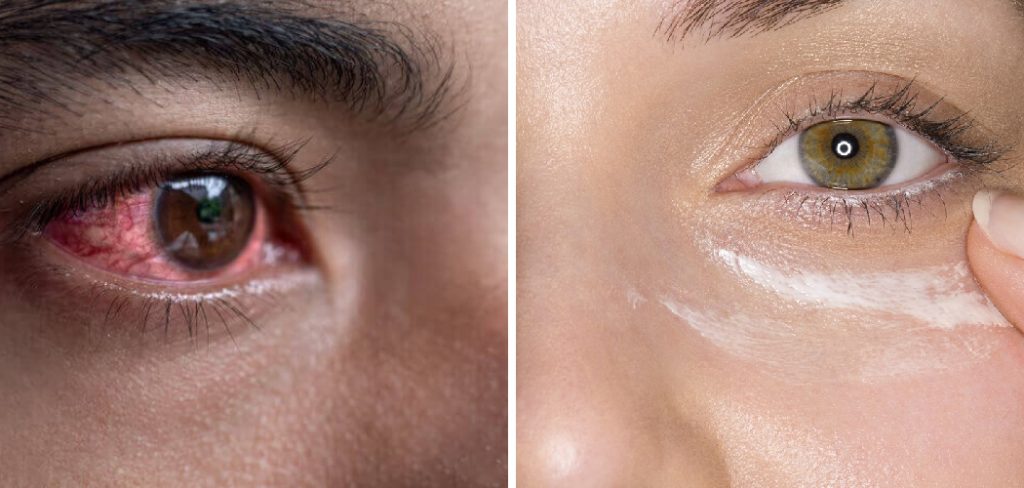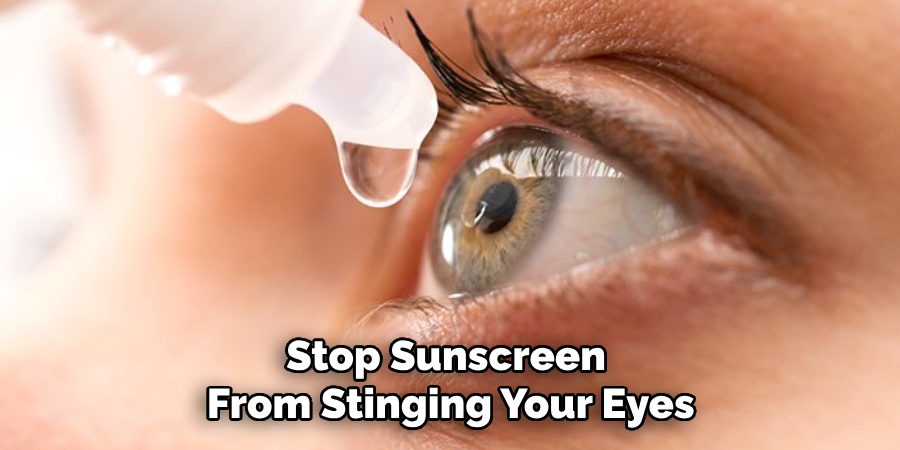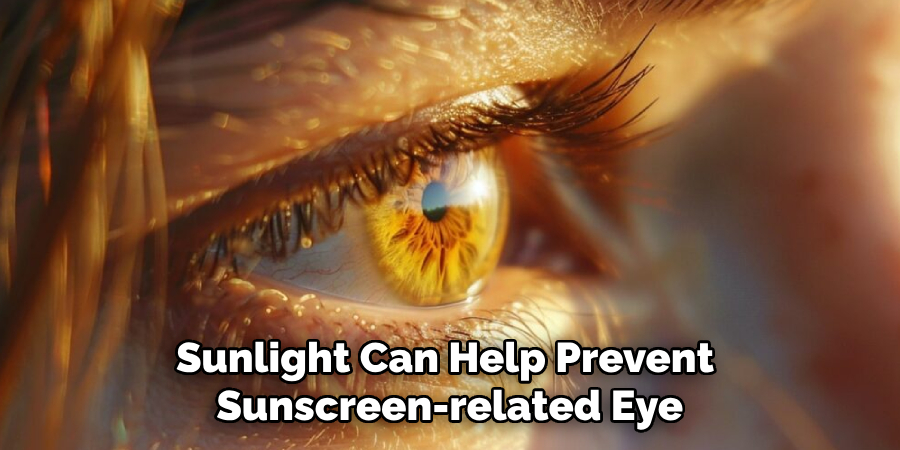Are you tired of sunscreen stinging your eyes every time you apply it? If so, you’re not alone. This common issue can be frustrating and even deter some people from adequately protecting their skin from the sun’s harmful rays.

Applying sunscreen is essential for protecting your skin from the harmful effects of UV radiation, but it can be quite a nuisance when it stings your eyes. This discomfort can turn an otherwise pleasant day outdoors into a painful experience. Fortunately, there are several strategies you can employ to prevent sunscreen from irritating your eyes.
Here, we will walk you through some tips on how to stop sunscreen stinging eyes and help you enjoy your time in the sun without any discomfort.
Why Do Sunscreens Sting Eyes?
Before we discuss the solutions, it’s essential to understand why sunscreen can sting your eyes. Most sunscreens contain active ingredients that absorb or prevent UV radiation from reaching and damaging your skin. These ingredients can sometimes also irritate the delicate tissue of your eyes, causing a stinging sensation.
Moreover, sweat—and water-resistant sunscreens may contain additional chemicals to help them adhere better to the skin, making them more likely to run into your eyes when you perspire or swim.
Overall, these factors contribute to the stinging sensation you may experience when using sunscreen.
What Will You Need?
To prevent sunscreen from stinging your eyes, you may need the following items:
- Sunscreen labeled “eye-friendly” or “non-comedogenic”
- A wide-brimmed hat
- Sunglasses to protect your eyes from UV rays
- Facial tissues or a clean towel
Once you have these items, you can implement the tips below and stop sunscreen from stinging your eyes.

10 Easy Steps on How to Stop Sunscreen Stinging Eyes
Step 1. Choose the Right Sunscreen
Select a sunscreen labeled “eye-friendly” or “non-comedogenic.” These products are specifically formulated to be less irritating to the delicate skin around your eyes. Look for sunscreens that use physical blockers like zinc oxide or titanium dioxide, as they are less likely to cause stinging than chemical absorbers.
Step 2. Avoid Applying Sunscreen Too Close to Your Eyes
Avoid applying sunscreen too close to your eyes, as even the mildest formulas can cause irritation if they get into your eyes. Instead, apply the sunscreen to your face, taking care to stop short of your eye sockets. For added protection around the eye area, consider using a sunscreen stick or a mineral-based product designed for use near the eyes. These products typically offer better adherence and are less likely to migrate into your eyes with sweat.
Step 3. Use a Wide-Brimmed Hat
Wearing a wide-brimmed hat can provide extra protection while reducing the amount of sunscreen needed on your face. The hat’s brim helps shield your eyes and face from direct sunlight, minimizing the risk of sunscreen running into your eyes as you perspire. A hat with a UPF rating can offer additional UV protection.

Step 4. Wear UV-Protective Sunglasses
Sunglasses are not just a summertime fashion accessory—they also play a crucial role in protecting your eyes from UV radiation. Choose sunglasses that provide 100% UV protection and ideally have a wraparound design to block sunlight from all angles. Sunglasses also prevent sweat mixed with sunscreen from dripping into your eyes by acting as a barrier.
Step 5. Opt for Water-Resistant Formulas
Water-resistant sunscreens are designed to adhere better to your skin, reducing the likelihood of them running into your eyes when you sweat, swim, or engage in other activities. Opting for a water-resistant formula ensures that sunscreen remains in place, even during humid conditions or intense physical activity. However, be mindful to check the duration of water resistance indicated on the product label, as it typically ranges from 40 to 80 minutes. Reapply regularly, especially after swimming or extensive sweating, to maintain effective protection. Furthermore, combining water-resistant sunscreen with a wide-brimmed hat and sunglasses fortifies your defense against eye irritation, making outdoor activities more enjoyable and comfortable.
Step 6. Pat Your Face Dry Instead of Rubbing
When your face becomes sweaty or wet, it’s crucial to handle it gently. Rather than rub your face with a towel, which can cause sunscreen to migrate into your eyes, use a clean towel or facial tissue to dry your face. Patting helps to keep the sunscreen in place while removing excess sweat and moisture. This method reduces the chances of the sunscreen mixing with sweat and running into your eyes. Always carry a small towel or tissues, especially during hot, humid weather or strenuous activities.
Step 7. Reapply Sunscreen Carefully
Reapplying sunscreen is essential for maintaining protection throughout the day, especially if you’re sweating or swimming. However, it’s essential to do so carefully to avoid accidentally getting sunscreen into your eyes. When reapplying, use small amounts and apply them with gentle patting motions. For the areas around your eyes, consider using a sunscreen stick or a mineral-based powder sunscreen, which is less likely to run or migrate into your eyes. Taking these precautions during reapplication ensures continuous protection without the discomfort of stinging eyes.

Step 8. Use a Sweatband or Headband
Wearing a sweatband or headband can be an effective way to prevent sunscreen from dripping into your eyes. These accessories absorb sweat before it can reach your face, reducing the possibility of sunscreen mixing with perspiration and running into your eyes. Select a sweatband or headband made from moisture-wicking fabric for optimal performance. This approach is advantageous during intense physical activities such as running, hiking, or playing sports, where sweat production is higher. You can enjoy your activities without worrying about irritation by keeping sweat and sunscreen away from your eyes.
Step 9. Wash Your Hands After Applying Sunscreen
Always wash your hands thoroughly after applying sunscreen to your face and body. Sunscreen residue on your hands can easily be transferred to your eyes if you touch or rub them, leading to potential irritation. Use soap and water to remove any remaining sunscreen from your hands to avoid accidental contact with your eyes. This simple yet effective step helps maintain comfortable and protected eyes throughout outdoor activities.
Step 10. Seek Shade During Peak Sun Hours
Whenever possible, seek shade during peak sun hours, typically between 10 a.m. and 4 p.m., when UV radiation is most intense. Limiting direct sun exposure reduces the need for frequent sunscreen application and minimizes the risk of it seeping into your eyes. Whether it’s sitting under a tree, using an umbrella, or finding a shaded area, taking breaks from direct sunlight can help prevent sunscreen-related eye irritation and provide an additional layer of protection for your skin and eyes.
By following these steps, you can effectively protect your skin and eyes from harmful UV rays without the discomfort of sunscreen in your eyes.

5 Additional Tips and Tricks
- Choose a Mineral Sunscreen: Unlike chemical sunscreens, mineral sunscreens contain zinc oxide or titanium dioxide, which sit on top of the skin and are less likely to cause irritation.
- Look for Sunscreens for Sensitive Skin: Many brands offer formulas specifically designed for sensitive skin. These are generally less irritating and often fragrance-free.
- Use a Sunscreen Stick: Compared to lotions or sprays, sunscreen sticks are less likely to drip into the eyes. Apply the stick sunscreen around the eye area to ensure it stays in place.
- Keep a Pocket-Sized Sunscreen: Keep a small sunscreen in your bag or pocket for on-the-go touch-ups, especially during outdoor activities.
- Check the Expiration Date: Sunscreen can lose its effectiveness over time, so be sure to check the expiration date and replace any expired products regularly.
With these additional tips and tricks, you can better protect your skin from the sun’s harmful UV rays. Remember always to reapply sunscreen every two hours and seek shade whenever possible. Don’t forget also to wear protective clothing and sunglasses for added protection.
5 Things You Should Avoid
- Avoid Using Chemical Sunscreens Around the Eyes: Chemical formulas can be more irritating, especially near sensitive eye areas. Opt for mineral-based sunscreens instead.
- Don’t Apply Sunscreen Too Close to the Eyes: Leave a small buffer zone around the eyes to minimize the risk of the product migrating and causing irritation.
- Refrain from Using Fragranced Sunscreens: Fragrances can trigger allergic reactions or stinging sensations, particularly in sensitive areas like around the eyes.
- Avoid Rubbing Your Eyes: After applying sunscreen, keep your hands away from your eyes to prevent any residual product from getting in them.
- Don’t Use Aerosol Sunscreens Around the Face: Sprays can easily enter your eyes during application, leading to stinging and discomfort. Stick to lotions or sticks for facial use.
By avoiding these common mistakes, you can ensure your sunscreen application is as safe and effective as possible. Always patch-test new products and consult a dermatologist if you experience any irritation or adverse reactions from sunscreen use.
What Can You Do If You Get Sunscreen in Your Eyes?
If you do happen to get sunscreen in your eyes, don’t panic. Here are some steps you can take to alleviate any discomfort:
- Rinse the Eye With Cool Water: This will help flush out any product that may have gotten into the eye.
- Use Artificial Tears: These can help soothe and lubricate the eyes if they feel dry or irritated.
- Apply a Cold Compress: Placing a cool, damp cloth over closed eyes can relieve and reduce redness.
- Seek Medical Attention if Needed: If irritation persists, you experience severe pain, or your vision changes, it’s best to seek medical attention as soon as possible.
Remember always to be gentle when dealing with delicate eye areas and avoid rubbing or touching your eyes.

Conclusion
In summary, how to stop sunscreen stinging eyes involves choosing the right products and following proper application techniques.
Opt for mineral sunscreens with zinc oxide or titanium dioxide, as they are less likely to irritate. Use formulations for sensitive skin, and avoid fragranced products that trigger stinging sensations. When applying sunscreen to your face, use sticks for targeted application around the eyes and leave a buffer zone to minimize the risk of migration. Keep your hands away from your eyes after application and avoid using aerosol sprays on your face.
Adhering to these guidelines protects your skin from harmful UV rays while ensuring your eyes remain comfortable and sting-free. If you experience discomfort, follow the recommended steps to alleviate symptoms and seek medical attention if necessary.
About the Author
Jane Hubbard is a passionate beauty expert with a wealth of experience in makeup, hair, and overall beauty techniques. After years of working as a hairdresser specialist, she followed her entrepreneurial spirit and started her own consultancy business.
Jane has always been driven by her desire to help others feel confident in their own skin, and she does this by sharing her knowledge, experiences, and practical beauty tips. Through her consultancy, she empowers individuals to embrace their unique beauty, offering tailored guidance that boosts both self-esteem and personal style.
Professional Focus
- Specializes in makeup, hairstyling, and beauty consulting.
- Provides personalized beauty advice, tips, and techniques to help individuals feel confident in their appearance.
- Dedicated to staying up-to-date with the latest industry trends and developments.
- Passionate about creating a comfortable and empowering experience for every client.
Education History
- University of Craft and Design – Bachelor of Fine Arts (BFA) in Woodworking and Furniture Design
- Woodworking Apprenticeships – Extensive hands-on training with skilled craftsmen to refine carpentry and furniture making techniques
- Online Courses & Masterclasses – Continued education in advanced woodworking techniques, design principles, and specialized tools
Expertise:
- Makeup artistry, hairstyling, and beauty consulting.
- Personalized beauty techniques to enhance confidence and self-expression.
- Educating clients on how to maintain their beauty routines at home.
